Cutting Garden Plants
Want to grow your own cut flowers? Here are tips on the best flowers to grow in your cutting garden. From your cutting garden, you can create bouquets from Spring through Summer.
Is there anything better than a vase of freshly cut flowers in your home? You can always pick up a bouquet of flowers in most grocery stores …which is a good and wonderful thing. But if you can pop out to your own personal cutting garden and clip your bouquet…well, that is just a ‘gooder’ and more ‘wonderfuller’ thing! Right?
Arranging a bowl of flowers in the morning can give a sense of quiet in a crowded day – like writing a poem or saying a prayer
Anne Morrow Lindbergh
I am smack in the midst of planting my cutting garden so that I’ll have flowers to cut for arrangements for the rest of the summer. I want to add some new flowers this year and so did a deep dive into plants that produce good flowers for cutting and flower arranging. As I’m wont to do, I’m sharing my findings with you here.
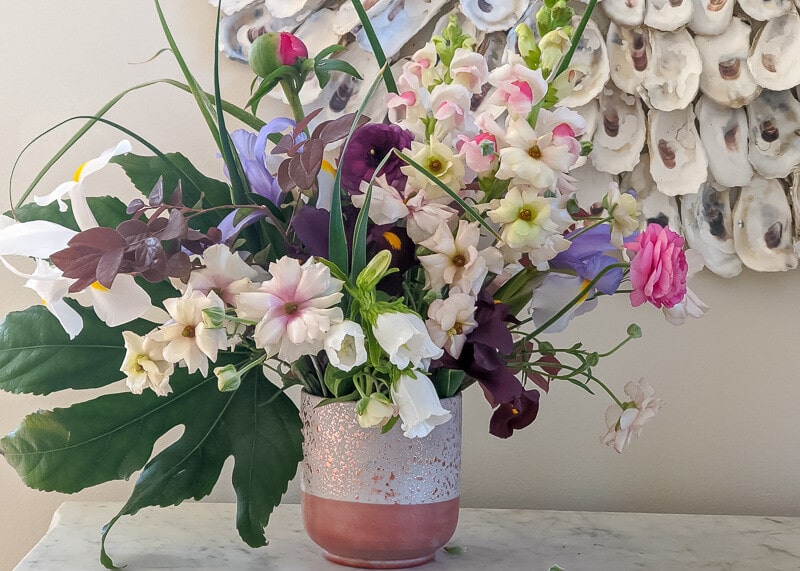
Table of Contents
What Are the Characteristics of a Good Cutting Garden Flower?
To summarize, you are looking for flowers that are not only easy to arrange in a vase, but also have a longer lifespan. However, growing roses can be a bit tricky, despite their beautiful appearance in a vase. Therefore, you also want to consider the ease of growing as a crucial characteristic when selecting plants for a cutting garden. Here are several characteristics to consider.
- Longevity: Flowers with a long vase life are preferred for arrangements, as they remain fresh and attractive for an extended period. This ensures that your arrangements stay beautiful for as long as possible.
- Low Maintenance: Flowers that require minimal maintenance, such as simple deadheading or occasional water changes, are preferred for arrangements. Low-maintenance flowers make creating and maintaining beautiful arrangements easier without constant attention.
- Strong and Long Stems: Flowers with sturdy and long stems are easier to work with in arrangements, as they support the blooms and prevent them from drooping or wilting prematurely.
- Abundant Blooms: Flowers that produce abundant blooms on each stem allow you to create fuller, more lush arrangements with fewer stems. This is especially useful for larger arrangements or when working with limited quantities of flowers.
- Color Range: Flowers in a wide range of colors provide flexibility in creating arrangements that match specific color schemes or themes. A diverse color palette allows for creativity and customization in arrangements.
- Fragrance: Flowers with a pleasant fragrance add an extra dimension to arrangements, enhancing the sensory experience and creating a more memorable impression. Fragrant flowers can also fill a room with their scent, adding to the ambiance.
- Ease of Growing: Some plants are just easier to grow than others! Consider your growing zone and how much time you want to devote to growing these flowers.
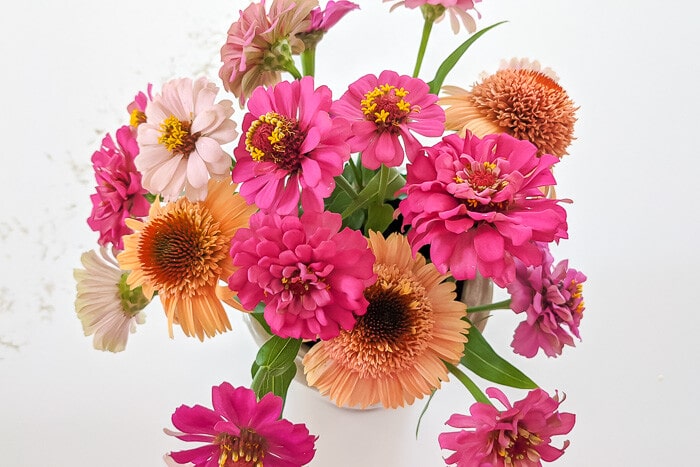
What Are Some Good Flowers to Grow in a Cutting Garden?
With these characteristics in mind, let’s consider thirty-four flowering plants for your cutting garden.
Ageratum
Ageratum is an annual flower with fluffy clusters of blue, purple, pink, or white blooms. While their delicate appearance is perfect for adding a soft, airy feel to bouquets, their short stems limit their use to smaller arrangements.

- Longevity: Good (5-7 days)
- Strong Stems: Moderate
- Stem Length: Short
- Abundant Blooms: Good
- Color Range: Blue, Purple, Pink, White
- Fragrance: Mild to None
- Low Maintenance: Excellent
- How Easy to Grow: Easy
- Best Growing Zone: 2-11
Asters
Asters are perennial flowers with daisy-like blooms in shades of blue, purple, pink, and white. They bloom in late summer to fall and are great for extending the cutting season.

- Longevity: Good (5-7 days)
- Strong Stems: Moderate
- Stem Length: Some varieties have long stems
- Abundant Blooms: Good to Excellent
- Color Range: Blue, Purple, Pink, White
- Fragrance: Mild to None
- Low Maintenance: Excellent
- How Easy to Grow: Easy to grow in zones 4-8
Avens (Geum)
Recently, I discovered Avens – a flower with long-lasting blooms, poppy-like flowers, and rich colors. They have become a treasured addition to my cutting garden, blooming from late spring through mid-summer.
- Longevity: Good (5-7 days)
- Strong Stems: Moderate
- Stem Length: Geum typically has medium-length stems, making it suitable for various arrangements.
- Abundant Blooms: Good
- Color Range: Various (depending on cultivar)
- Fragrance: Mild to None
- Low Maintenance: Moderate
- How Easy to Grow: Moderately easy to grow. Prefers low humidity and afternoon shade in hot climates.
- Best Growing Zone: 4-7
Bachelor’s Buttons (Cornflowers)
Bachelor’s buttons are annual flowers with bright blue, pink, or white blooms. They have a long blooming season and are great for adding color to arrangements.

- Longevity: Good (5-7 days)
- Strong Stems: Moderate
- Stem Length: Bachelor’s buttons have medium-length stems, making them versatile for different types of arrangements.
- Abundant Blooms: Good
- Color Range: Blue, Pink, White
- Fragrance: Mild to None
- Low Maintenance: Excellent
- How Easy to Grow: Easy
- Best Growing Zone: Zones 2-11
Celosia (Cockscomb)
Celosia is an annual flower with vibrant, velvety blooms that resemble the comb of a rooster. It comes in various colors and is great for adding bold color and texture to arrangements.

- Longevity: Good (5-7 days)
- Strong Stems: Excellent
- Stem Length: Celosia often has short to medium-length stems, depending on the variety, making it suitable for both compact and taller arrangements.
- Abundant Blooms: Good
- Color Range: Red, Orange, Yellow
- Fragrance: Mild to None
- Low Maintenance: Moderate
- How Easy to Grow: Easy
- Best Growing Zone: Zones 2-11
Chrysanthemums
Chrysanthemums, or mums, are perennial flowers with pom-pom-like blooms in various colors. They bloom in fall and are popular in autumn arrangements.
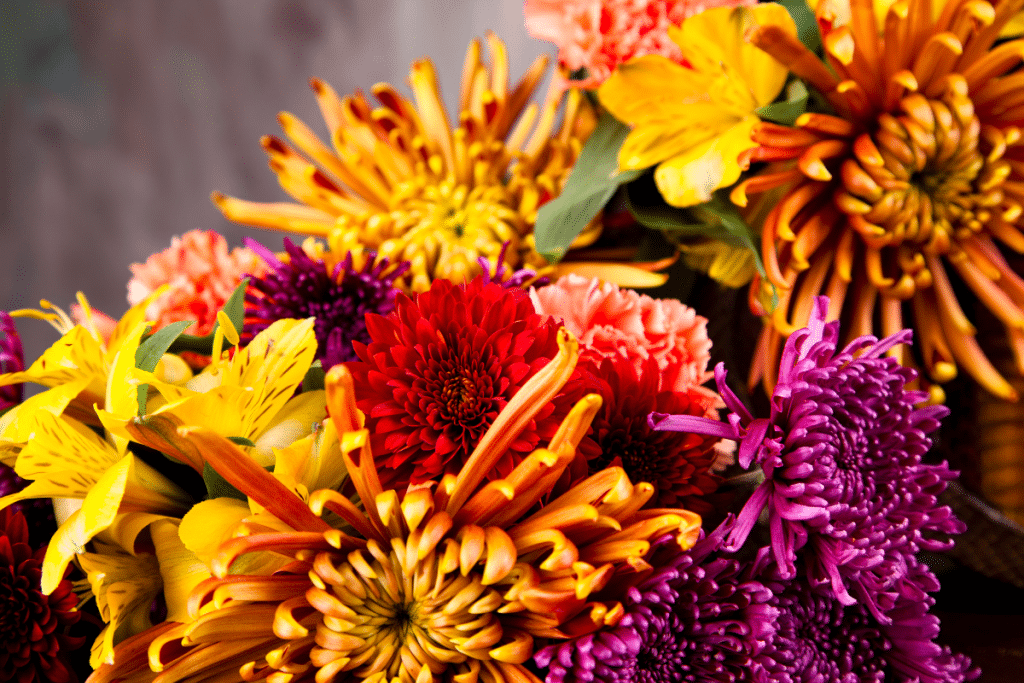
- Longevity: Good to Excellent (5-10 days)
- Strong Stems: Excellent
- Stem Length: Mums usually have medium to long stems, making them ideal for taller floral designs.
- Abundant Blooms: Excellent
- Color Range: Various
- Fragrance: Mild to None
- Low Maintenance: Moderate
- How Easy to Grow: A little difficult. They have shallow roots, so they need regular water. They also need heavy pinching.
- Best Growing Zone: Zones 5-9
Cosmos
Cosmos are annual flowers with delicate, daisy-like blooms that come in shades of pink, white, and purple. They have a long blooming season and attract pollinators.

- Longevity: Good (5-7 days)
- Strong Stems: Moderate
- Stem Length: Cosmos typically have long, slender stems, making them perfect for adding height and movement to arrangements.
- Abundant Blooms: Excellent
- Color Range: Excellent
- Fragrance: Mild to None
- Low Maintenance: Excellent
- How Easy to Grow: Easy
- Best Growing Zone: Zones 2-11
Dahlias
Long-stemmed dahlias are perfect for cut flower arrangements. This perennial will produce flowers all growing season like an annual, but its tubers will produce again the following if not too cold. Digging the tubers up in cold climates and wintering them in your garage or unheated basement is best.
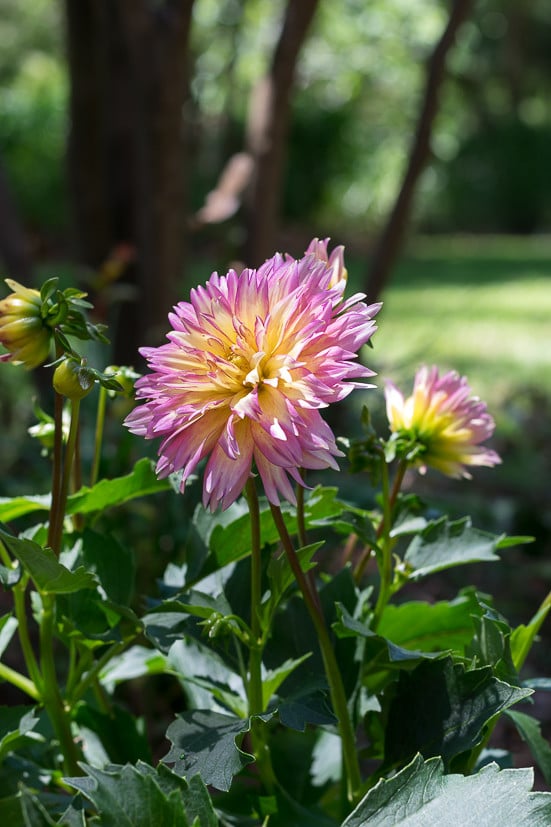
When properly treated after they’ve been cut, they will last longer than many other flowers and grow in just about every color and shape. They are ideal for any cut flower garden, large or small, beginner or expert! I put the cut tip of the stems of my dahlias into hot, but not boiling water right after I cut them. While I’m unsure of the ‘why this works’ of this practice, I know it helps the blooms last several days longer than if it isn’t done.
- Longevity: Good (5-7 days)
- Strong Stems: Excellent
- Stem Length: Dahlias can have short to long stems, depending on the variety, making them versatile for various types of arrangements.
- Abundant Blooms: Excellent
- Color Range: Excellent
- Fragrance: Mild to None
- Low Maintenance: Moderate
- How Easy to Grow: Dahlias can be challenging. Each year, they require careful planting, staking, pinching, digging, and storing the tubers over the winter. They don’t like cold weather or wet soil.
- Best Growing Zone: Zones 8-11 (tubers can be dug up and stored in colder zones for winter)
Daisies (Shasta daisies, Gerbera daisies)
Daisies are perennial flowers with cheerful and bright yellow centers. They come in various sizes and colors and add a rustic touch to bouquets.
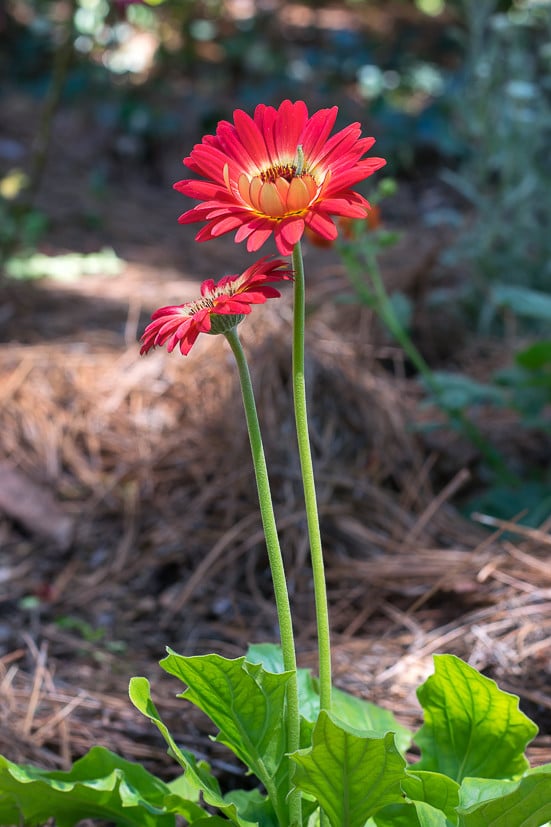
I love the bright, playful colors of the Gerber Daisies, but don’t often mix them with other flowers as they don’t do well when their hollow stems are submerged as much as other flowers in an arrangement.
Consider keeping these flowers in their own vase, in only 2-3 inches of water. Changing their water and snipping the ends of the stems just a wee bit each day will help them last longer.
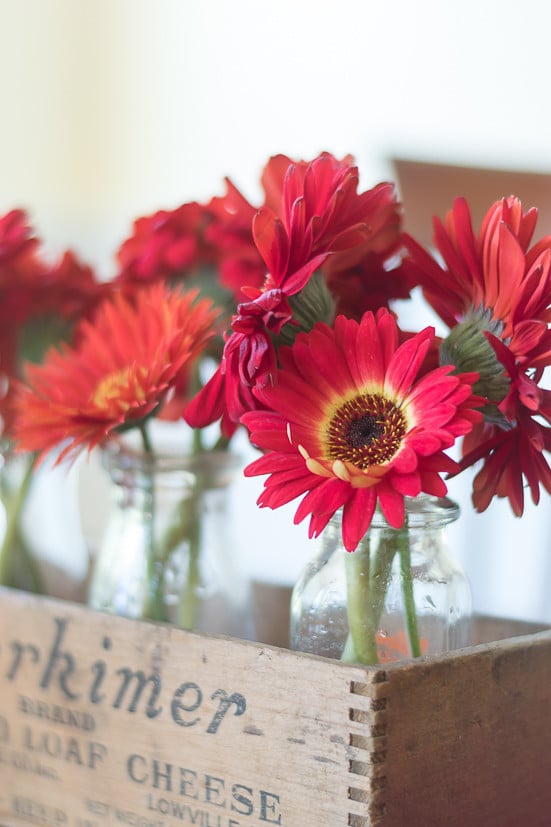
It’s hard to beat the workhorse Shasta Daisy in your summer floral arrangements. They play well with others.

What’s a cutting garden without daisies?
- Longevity: Good (5-7 days)
- Strong Stems: Moderate
- Stem Length: Daisies usually have medium-length stems, suitable for a wide range of arrangements.
- Abundant Blooms: Moderate to Excellent
- Color Range: White, Yellow, Pink
- Fragrance: Mild to None
- Low Maintenance: Excellent
- How Easy to Grow: Easy, but requires deadheading throughout the season.
- Best Growing Zone: Zones 4-9
Delphiniums
Delphiniums are perennial flowers with tall spikes of densely packed, vibrant blooms in shades of blue, purple, pink, and white. They’re perfect for adding vertical interest to arrangements.

- Longevity: Good (5-7 days)
- Strong Stems: Excellent
- Stem Length: Delphiniums are known for their tall spikes of blooms, with long stems ideal for creating height in arrangements.
- Abundant Blooms: Good to Excellent
- Color Range: Blue, Purple, Pink, White
- Fragrance: Mild to None
- Low Maintenance: Moderate
- How Easy to Grow: They can be difficult to grow in, depending on your location. They require cool, mild summers with low humidity and are prone to fungus.
- Best Growing Zone: Zones 3-7
Echinacea (Coneflowers)
Coneflowers are a great choice for pollinators and a must-have for any summer garden. They bloom in a range of colors from June through September and have a long vase life, making them perfect for adding structure to floral arrangements. Additionally, many floral arrangers use the cones of coneflowers in their arrangements after the petals have fallen. When planting my cut flower garden, I always make sure to include these beauties in my selection.

- Longevity: Good (5-7 days)
- Strong Stems: Moderate
- Stem Length: Coneflowers typically have medium-length stems, suitable for various types of arrangements.
- Abundant Blooms: Moderate to Excellent
- Color Range: Purple, Pink, White, Orange
- Fragrance: Mild to None
- Low Maintenance: Excellent
- How Easy to Grow: Relatively easy to grow.
- Best Growing Zone: Zones 3-9
Freesia
Freesias are popular flowers for flower arranging due to their fragrant blooms and delicate appearance. They add elegance and charm to bouquets and floral displays.

- Longevity: Good (5-7 days)
- Strong Stems: Moderate
- Stem Length: Freesias typically have medium-length stems, making them suitable for various types of arrangements, from compact bouquets to taller floral designs.
- Abundant Blooms: Good
- Color Range: Various (often pastel shades)
- Fragrance: Excellent
- Low Maintenance: Moderate
- How Easy to Grow: Only hardy in zones 9-11, so you’d have to dig up the corns below that. They don’t like wet soil.
- Best Growing Zone: Zones 9-10 (often grown as an annual in colder zones)
Gladiolus
Gladiolus are perennial flowers with tall spikes of trumpet-shaped blooms in a wide range of colors. They’re perfect for adding height and drama to arrangements. I can’t see or hear of gladiolus without thinking of my grandma, who loved these flowers and would try to grow them wherever we lived. They are a wonderfully old-fashioned flower.

- Longevity: Good (5-7 days)
- Strong Stems: Excellent
- Stem Length: Glads have long stems, suitable for tall arrangements.
- Variety of Sizes and Shapes: Good
- Color Range: Excellent
- Fragrance: Mild to None
- Low Maintenance: Moderate
- How Easy to Grow: They need full sun and are only hardy in zones 7 and up. Gladiolus can be grown annually in colder zones.
Gomphrena (Globe amaranth)
Gomphrena is an annual flower with round, clover-like blooms in pink, purple, and white shades. They’re perfect for adding texture and interest to arrangements.
Globe-y flowers like gomphrena or allium add a little fun and whimsy to arrangements.
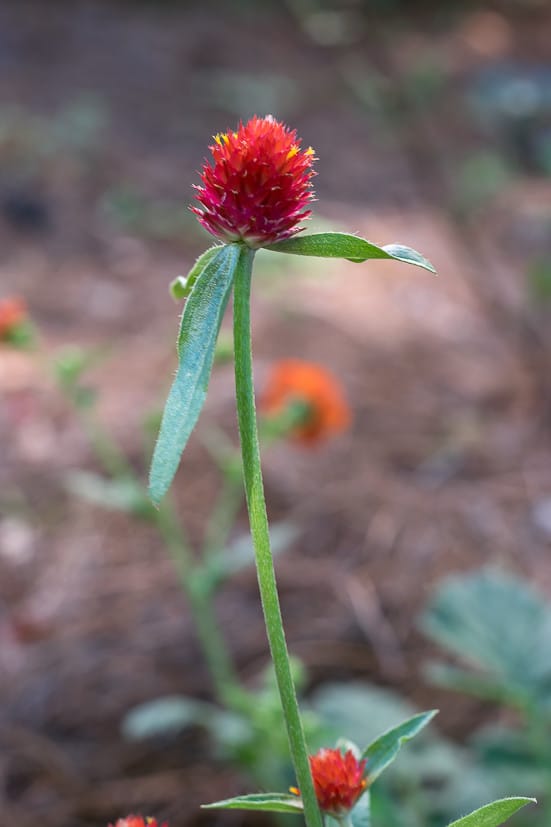
- Longevity: Good (5-7 days)
- Strong Stems: Moderate
- Stem Length: Gomphrena often has short to medium-length stems, making it suitable for compact arrangements.
- Abundant Blooms: Excellent
- Color Range: Pink, Purple, White
- Fragrance: Mild to None
- Low Maintenance: Excellent
- How Easy to Grow: Easy! Low-maintenance plant that is not heat sensitive and can tolerate dry conditions.
- Best Growing Zone: Zones 2-11
Gypsophila (Baby’s breath)
Gypsophila is an annual or perennial flower with delicate, cloud-like clusters of tiny white blooms. They’re perfect for adding a soft, romantic feel to arrangements.

- Longevity: Good (5-7 days)
- Strong Stems: Moderate
- Stem Length: Baby’s breath has long, delicate stems, perfect for adding texture and airiness to arrangements.
- Abundant Blooms: Excellent
- Color Range: White
- Fragrance: Mild to None
- Low Maintenance: Excellent
- How Easy to Grow: Baby’s breath is easy to grow in most climates, thriving in well-drained soil and full sun.
- Best Growing Zone: Zones 3-9
Iris
Irises are excellent choices for cutting gardens due to their stunning blooms, which come in a variety of colors and shapes. They add elegance and sophistication to floral arrangements. My wedding bouquet was filled with lovely purple irises, they have long been one of my favorites.
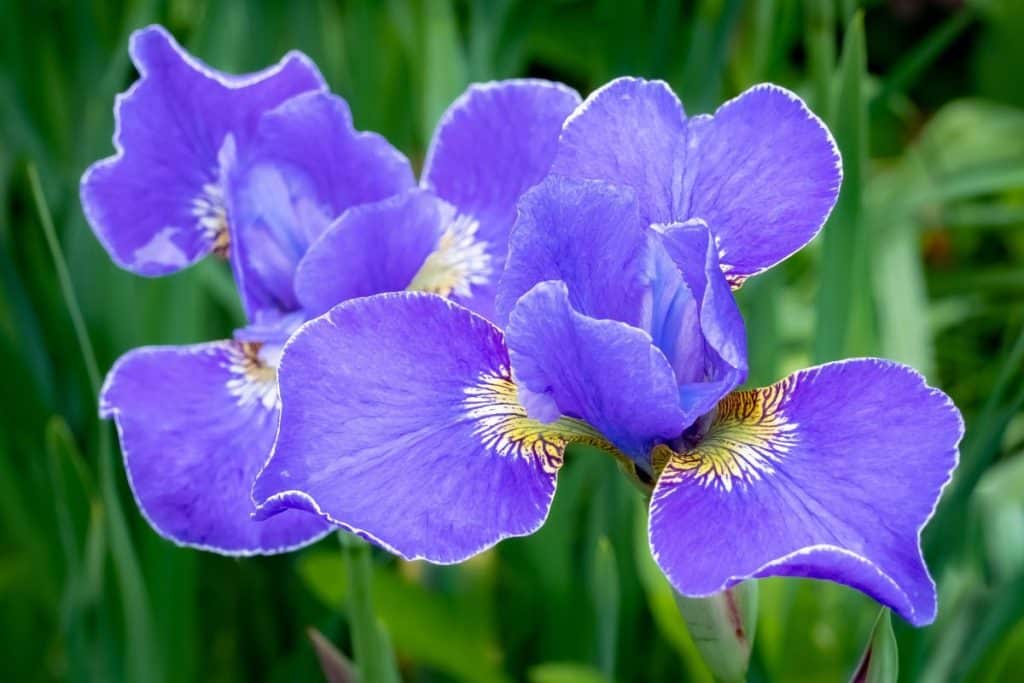
- Longevity: Good (5-7 days)
- Strong Stems: Moderate
- Stem Length: With their medium to long stem lengths and adaptability to various design styles, irises are versatile and valuable additions to any cutting garden.
- Abundant Blooms: Excellent
- Color Range: Irises come in various colors, including shades of purple, blue, white, yellow, pink, orange, and even bi-color varieties.
- Fragrance: None
- Low Maintenance: Excellent
- How Easy to Grow: Irises are relatively easy to grow, thriving in zones 3-9.
Lavender
Lavender is a perennial herb prized for its fragrant, purple-blue flowers and aromatic foliage. It’s perfect for adding scent and texture to bouquets and is also used in herbal crafts.
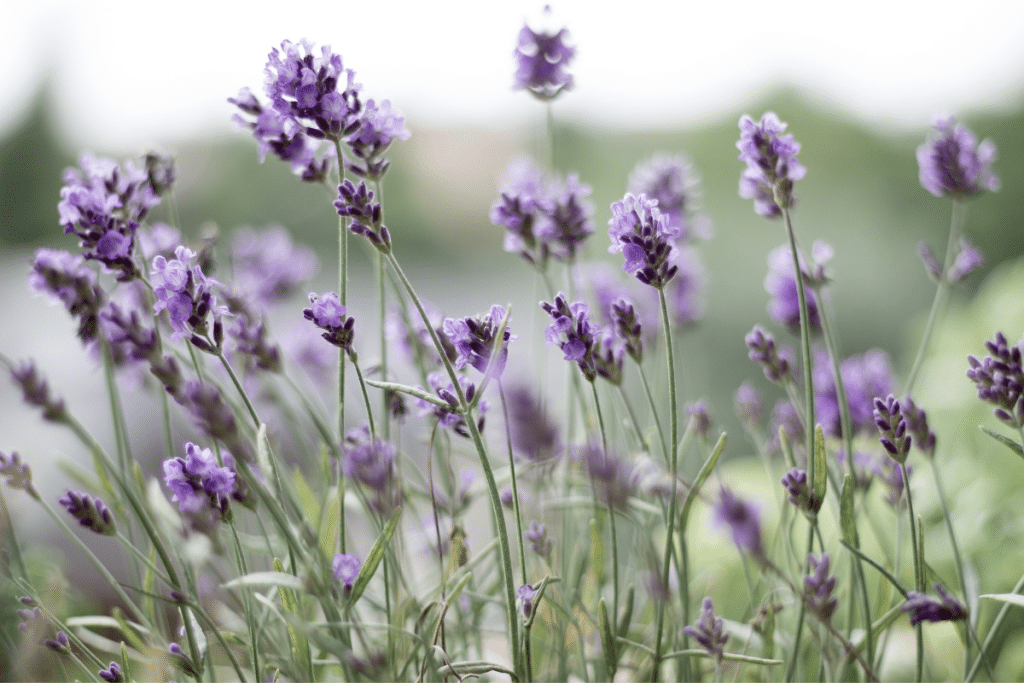
- Longevity: Good (5-7 days)
- Strong Stems: Moderate
- Stem Length: Lavender usually has short to medium-length stems, making it versatile for various arrangements.
- Abundant Blooms: Moderate
- Color Range: Lavender/Purple
- Fragrance: Excellent
- Low Maintenance: Excellent
- How Easy to Grow: Lavender is generally easy to grow, preferring dry, well-drained soil and full sun.
- Best Growing Zone: Zones 5-9
Lilies (Asiatic, Oriental, and hybrids)
Lilies are perennial flowers known for their elegant, trumpet-shaped blooms and sweet fragrance. They come in various colors and are perfect for adding sophistication to bouquets.

- Longevity: Excellent (7-10 days)
- Strong Stems: Excellent
- Stem Length: Lilies have long stems, perfect for creating dramatic focal points in arrangements.
- Abundant Blooms: Moderate to Excellent
- Color Range: Various
- Fragrance: Excellent
- Low Maintenance: Moderate
- How Easy to Grow: Lilies are relatively easy to grow, requiring well-drained soil and full sun to partial shade.
- Best Growing Zone: Zones 3-9
Lisianthus (Eustoma)
Lisianthus, also known as Texas bluebells, are annual or perennial flowers with rose-like blooms in shades of pink, purple, white, and blue. They have a long vase life and are popular in wedding arrangements.

- Longevity: Excellent (7-10 days)
- Strong Stems: Moderate to Excellent
- Stem Length: Lisianthus often has medium-length stems, suitable for a wide range of arrangements.
- Abundant Blooms: Moderate to Excellent
- Color Range: Excellent
- Fragrance: Mild to Moderate
- Low Maintenance: Moderate
- How Easy to Grow: Lisianthus can be moderately challenging to grow, needing rich, well-drained soil and full sun.
- Best Growing Zone: Zones 8-10 (can be grown as an annual in colder zones
Nigella (Love-in-a-Mist)
Nigella is an annual flower with delicate, fern-like foliage and unique, star-shaped blooms in shades of blue, pink, and white. They’re perfect for adding texture and interest to arrangements.

- Longevity: Good (5-7 days)
- Strong Stems: Moderate
- Stem Length: Nigella typically has short to medium-length stems, making it versatile for various types of arrangements.
- Abundant Blooms: Good
- Color Range: Blue, Pink, White
- Fragrance: Mild to None
- Low Maintenance: Moderate
- How Easy to Grow: Nigella easily grows from seed, thriving in well-drained soil and full sun to partial shade.
- Best Growing Zone: Zones 2-11
Peonies
Peonies are perennial flowers known for their large, fluffy blooms and delightful fragrance. They come in shades of pink, white, and red and are popular in wedding bouquets.

- Longevity: Excellent (7-10 days)
- Strong Stems: Moderate to Excellent
- Stem Length: Peonies usually have medium to long stems, ideal for creating lush, romantic arrangements.
- Abundant Blooms: Moderate
- Color Range: Pink, White, Red
- Fragrance: Excellent
- Low Maintenance: Moderate
- How Easy to Grow: Peonies are moderately easy to grow and long-lived, preferring well-drained soil and full sun
- Best Growing Zone: Zones 3-8
Roses
Roses are classic flowering plants loved for their beautiful, fragrant blooms. They come in various colors, sizes, and forms, making them versatile for arrangements.

- Longevity: Good to Excellent (5-10 days)
- Strong Stems: Excellent
- Stem Length: Roses have medium to long stems, perfect for classic, elegant arrangements.
- Abundant Blooms: Moderate to Excellent
- Color Range: Excellent
- Fragrance: Excellent
- Low Maintenance: Moderate
- How Easy to Grow: Certain varieties are low maintenance. In general, they need well-drained soil and full sun.
- Best Growing Zone: Zones 4-9 (varies by variety)
Rudbeckia (Black-eyed Susans)
Rudbeckia is a perennial flower with cheerful yellow, orange, or red blooms with dark centers. They’re perfect for adding a rustic touch to arrangements.

- Longevity: Good to Excellent (5-10 days)
- Strong Stems: Moderate to Excellent
- Stem Length: Rudbeckia often has medium-length stems, which are suitable for various types of arrangements.
- Abundant Blooms: Moderate to Excellent
- Color Range: Yellow, Orange, Red
- Fragrance: Mild to None
- Low Maintenance: Excellent
- How Easy to Grow: Rudbeckia is easy to grow in most conditions, thriving in well-drained soil and full sun
- Best Growing Zone: Zones 3-9
Salvia
Salvia is a perennial flower with spiky blooms in shades of blue, purple, red, and white. They’re perfect for attracting pollinators to the garden and adding height to arrangements.

- Longevity: Good (5-7 days)
- Strong Stems: Moderate to Excellent
- Stem Length: Salvia usually has medium to long stems, making it versatile for different types of arrangements.
- Abundant Blooms: Moderate
- Color Range: Blue, Purple, Red, White
- Fragrance: Mild to None
- Low Maintenance: Excellent
- How Easy to Grow: Salvia is easy to grow, preferring well-drained soil and full sun.
- Best Growing Zone: Zones 4-11
Scabiosa
Scabiosa, or pincushion flower, is an annual or perennial flower with delicate, pincushion-like blooms in shades of blue, pink, and white. They’re perfect for adding a whimsical touch to arrangements.
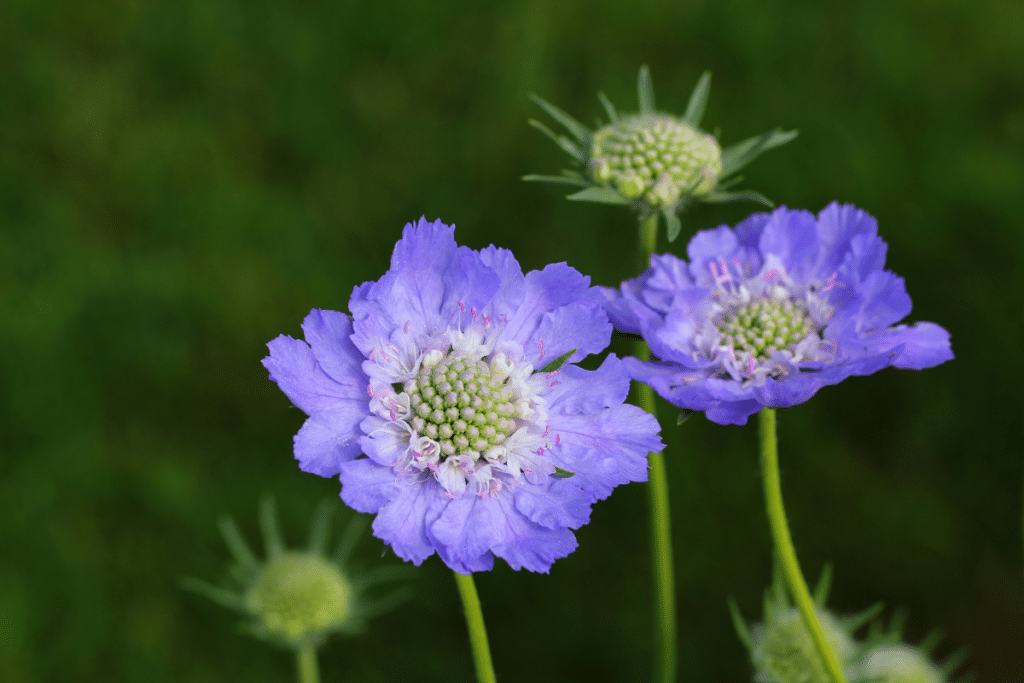
- Longevity: Good (5-7 days)
- Strong Stems: Moderate
- Stem Length: Scabiosa typically has long, wiry stems, making it ideal for adding height and whimsy.
- Abundant Blooms: Moderate
- Color Range: Blue, Pink, White
- Fragrance: Mild to None
- Low Maintenance: Excellent
- How Easy to Grow: Scabiosa is easy to grow in well-drained soil and full sun to partial shade.
- Best Growing Zone: Zones 3-9
Snapdragons
Snapdragons are annual or perennial flowers with tall spikes of colorful, snapdragon-shaped blooms. They come in various colors and are known for their unique, snap-like opening mechanism.
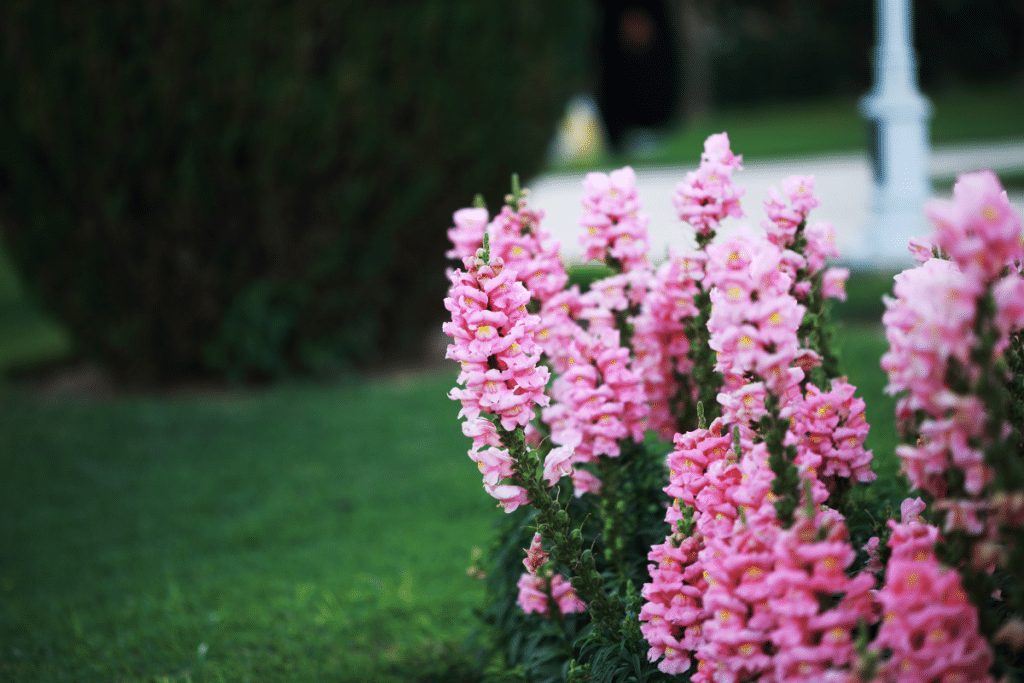
- Longevity: Good (5-7 days)
- Strong Stems: Excellent
- Stem Length: Snapdragons have tall spikes with medium to long stems, perfect for creating vertical interest in arrangements.
- Abundant Blooms: Moderate to Excellent
- Color Range: Good to Excellent
- Fragrance: Mild to None
- Low Maintenance: Moderate
- How Easy to Grow: Snapdragons are relatively easy to grow from seed, thriving in well-drained soil and full sun. They prefer cooler temperatures, so they are great in spring but slow down in summer heat.
- Best Growing Zone: Zones 7-10 (can be grown as an annual in colder zones)
Statice
Statice is an annual or perennial flower with papery clusters of blooms in shades of blue, purple, pink, and white. They’re perfect for adding texture and interest to arrangements.
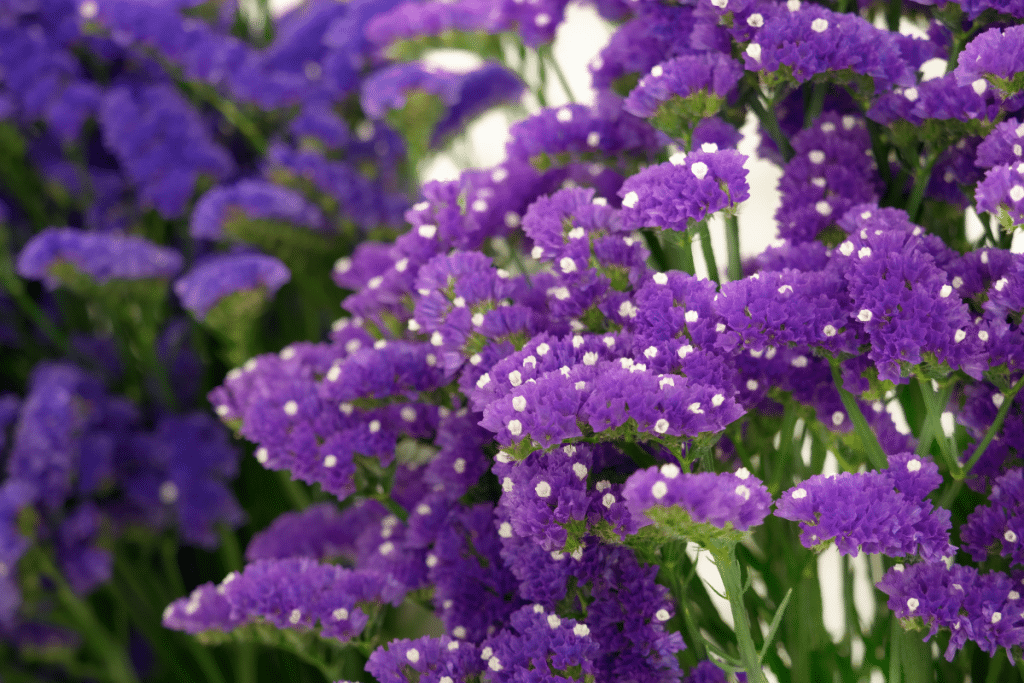
- Longevity: Good (5-7 days)
- Strong Stems: Moderate
- Stem Length: Statice often has medium-length stems, suitable for various types of arrangements and adding texture.
- Abundant Blooms: Moderate to Excellent
- Color Range: Blue, Purple, Pink, White
- Fragrance: Mild to None
- Low Maintenance: Excellent
- How Easy to Grow: Statice is easy to grow in well-drained soil and full sun.
- Best Growing Zone: Zones 3-9
Stock

- Longevity: Good (5-7 days)
- Strong Stems: Moderate to Excellent
- Stem Length: Stock usually has long, sturdy stems, making it ideal for creating full, fragrant arrangements.
- Abundant Blooms: Good to Excellent
- Color Range: Various (often pastel shades)
- Fragrance: Excellent
- Low Maintenance: Moderate
- How Easy to Grow: Stock is easy to grow from seed, thriving in well-drained soil and full sun.
- Best Growing Zone: Zones 7-10 (often grown as an annual in colder zones)
Sunflowers
Nothing says ‘summer bouquet’ like Sunflowers, which come in a variety of sizes and shades of yellow.
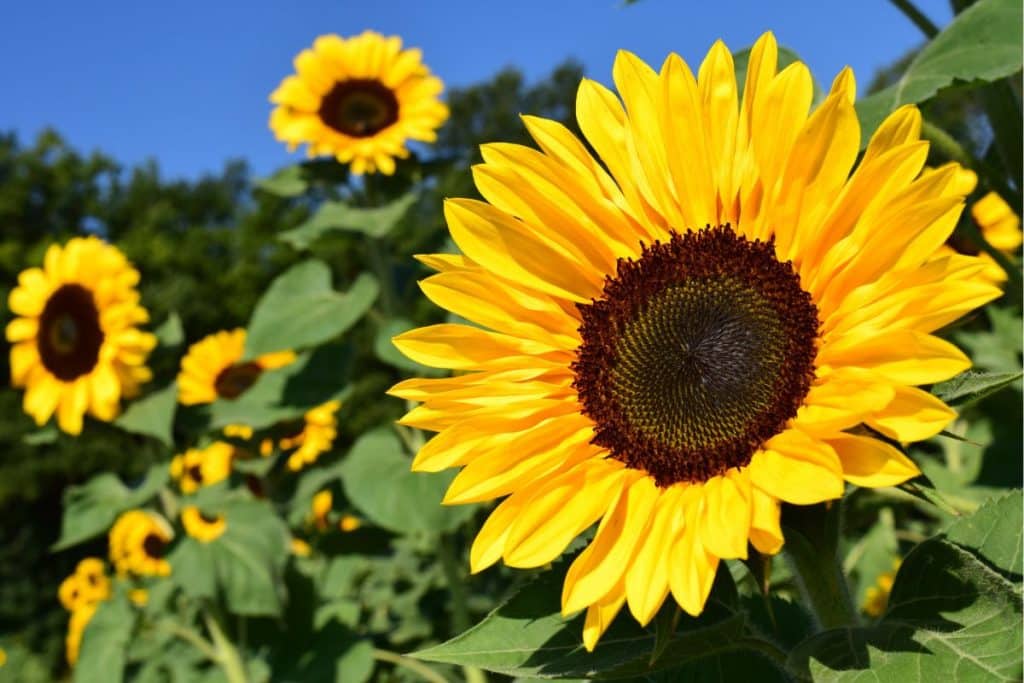
- Longevity: Good (5-7 days)
- Strong Stems: Excellent
- Stem Length: Tall stems, perfect for height in festive arrangements.
- Abundant Blooms: Excellent
- Color Range: Mostly yellow, some red, orange, and brown varieties.
- Fragrance: Mild to None
- Low Maintenance: Excellent
- How Easy to Grow: Sunflowers are easy to grow, preferring well-drained soil and full sun.
- Best Growing Zone: Zones 4-9
Sweet Peas
Sweet peas are annual climbing plants with fragrant, pea-like flowers in shades of pink, purple, white, and blue. They’re perfect for adding a romantic, trailing element to arrangements.
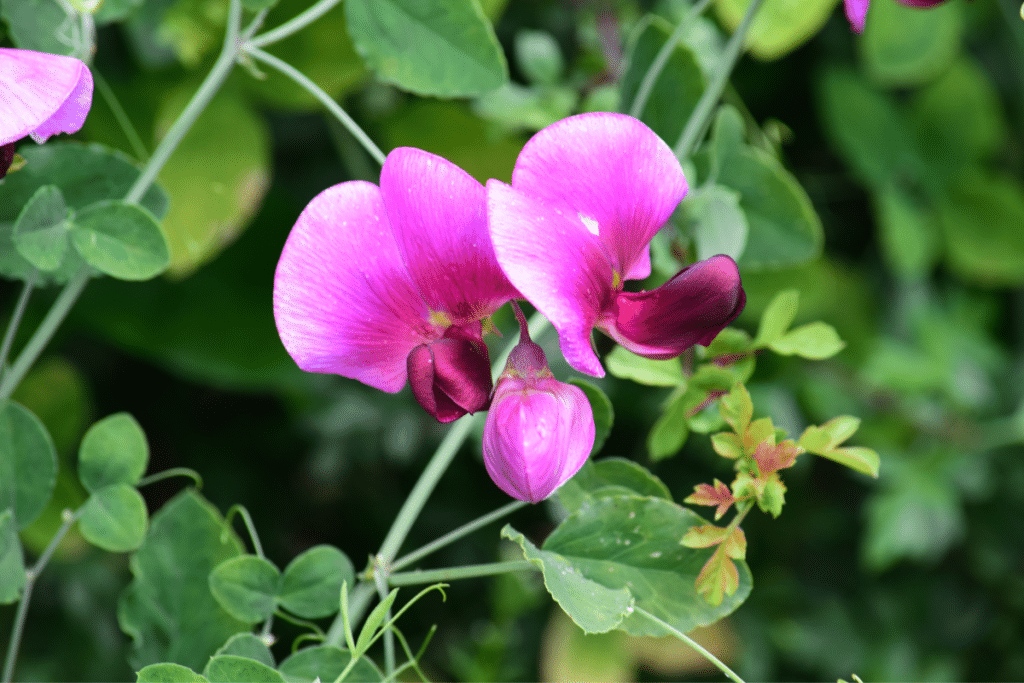
- Longevity: Good (3-5 days)
- Strong Stems: Moderate
- Stem Length: Sweet peas have medium-length, trailing stems, perfect for adding a romantic, cascading effect to arrangements.
- Abundant Blooms: Good
- Color Range: Pink, Purple, White, Blue
- Fragrance: Heavenly!
- Low Maintenance: Moderate
- How Easy to Grow: Sweet peas can be moderately challenging to grow, needing rich, well-drained soil and full sun, but cool temperatures.
- Best Growing Zone: Zones 2-11
Tulips
Tulips are spring-blooming bulbs known for their cup-shaped flowers in various colors. They’re popular in floral arrangements and symbolize love and rebirth.
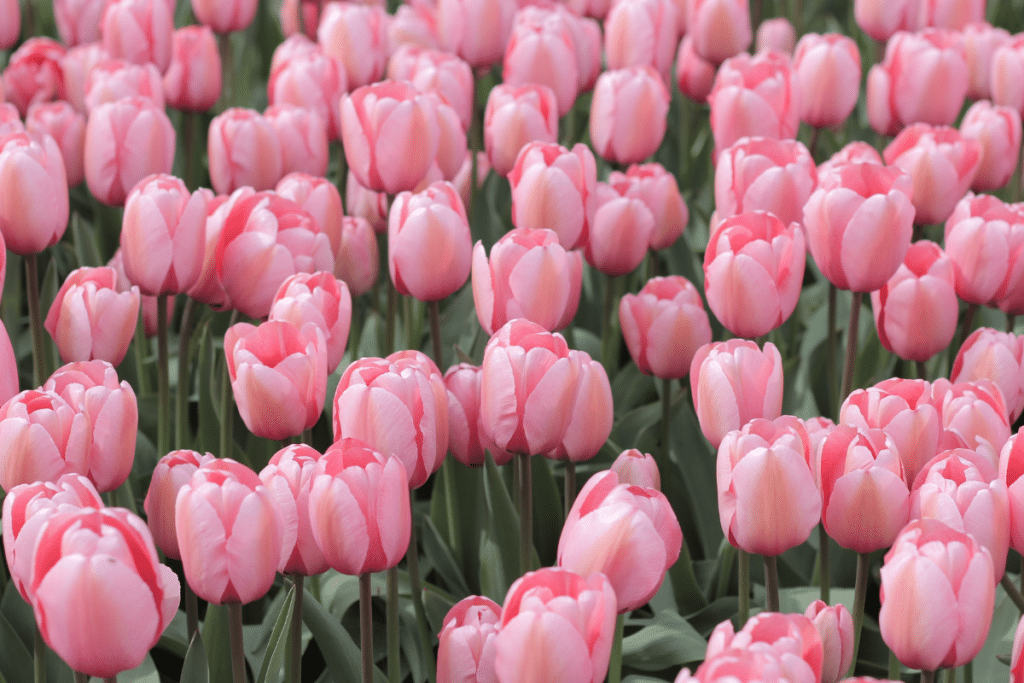
- Longevity: Good (5-7 days)
- Strong Stems: Good to Excellent
- Stem Length: Tulips have long, straight stems, making them ideal for creating elegant, linear arrangements.
- Abundant Blooms: Moderate
- Color Range: Various (except blue)
- Fragrance: Mild to None
- Low Maintenance: Moderate
- How Easy to Grow: Tulips are generally easy to grow, requiring well-drained soil and full sun to partial shade.
- Best Growing Zone: Zones 3-8
Veronica
Veronica is a perennial flower with slender spikes of tiny blooms in shades of blue, pink, and white. They’re perfect for adding vertical interest and texture to arrangements.

- Longevity: Good (5-7 days)
- Strong Stems: Moderate
- Stem Length: Veronica typically has medium to long stems, perfect for adding vertical interest and texture to arrangements.
- Abundant Blooms: Moderate to Excellent
- Color Range: Blue, Pink, White
- Fragrance: Mild to None
- Low Maintenance: Excellent
- How Easy to Grow: Veronica can grow in well-drained soil and full sun to partial shade.
- Best Growing Zone: Zones 3-8
Yarrow
The gray-green leaves of Yarrow provide lovely contrast in most flower arrangements, in addition to the subtle pops of color provided by the blooms. They should be on your list of best flowers for your cutting garden.
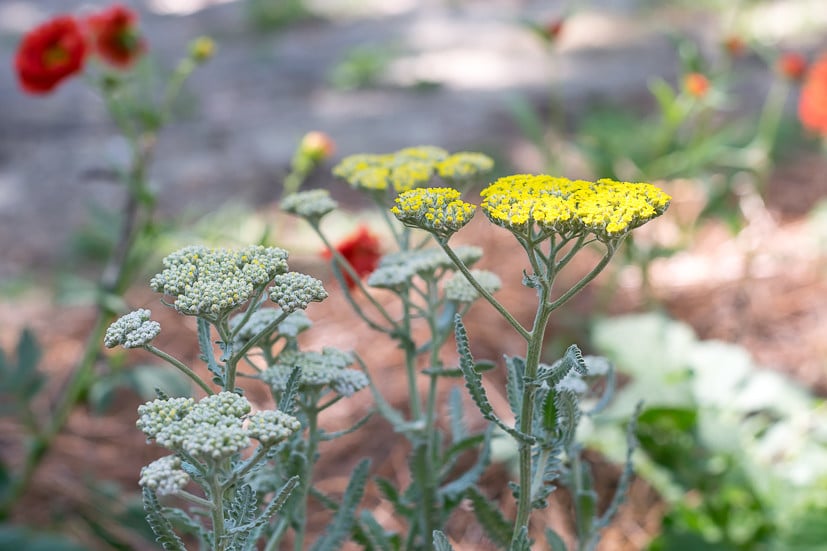
- Longevity: Good, 7-10 days after being cut.
- Strong Stems: Strong, sturdy stems
- Stem Length: Yarrow usually has tall, sturdy stems, making it suitable for various types of arrangements and providing structural support.
- Abundant Blooms: Excellent
- Color Range: White, yellow, pink, and red.
- Fragrance: Mild
- Low Maintenance: Excellent
- How Easy to Grow: Yarrow thrives in well-drained soil and full sun but can tolerate partial shade. Once established, it is drought-tolerant and requires minimal maintenance.
- Best Growing Zone: Zones 3-9
Zinnias
Zinnias are some of my all-time favorites for cut flower arrangements. There is something quaint about the simple but very colorful flower. Plant your zinnias from seed, as they don’t tend to do well if transplanted.
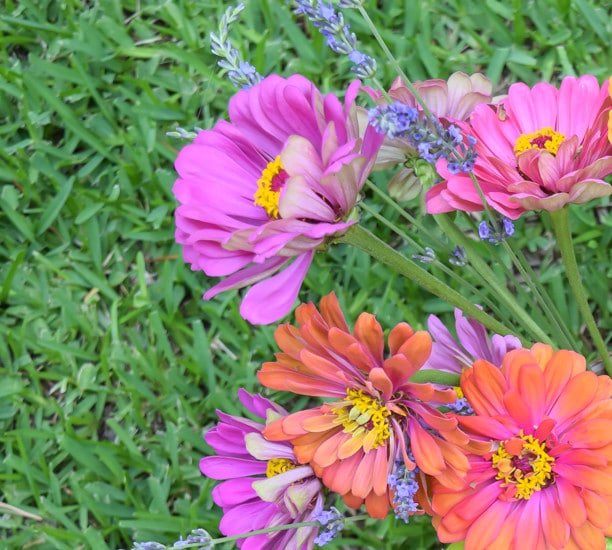
- Longevity: Good (5-14 days)
- Strong Stems: Moderate
- Stem Length: Zinnias have medium to long stems, depending on the variety, making them versatile for different types of arrangements and adding color and vibrancy.
- Abundant Blooms: Excellent
- Color Range: Excellent
- Fragrance: Mild to None
- Low Maintenance: Excellent
- How Easy to Grow: Very easy to grow from seed. Zinnias generally do not transplant well because they have delicate roots that can be easily disturbed during transplanting. It’s typically recommended to directly sow zinnia seeds where they are intended to grow to avoid disrupting their growth and development.
- Best Growing Zone: Zones 3-10
Whew! What do you think? Did you get some new inspiration for your cutting garden? I know there are more plants out there that are perfect for a cut flower garden. I’ve tried to wrap this post up several times, but then I remembered another plant to add to add to the list. If your favorite isn’t on the list, send me an email, and I’ll add it. I promise this list will continue to grow.
Greens to Use For Fill and Foliage in Your Flower Arrangements
In addition to snipping flowers from your cutting garden for an arrangement, shop your yard for greens that you can add.
- Cast Iron Plant leaves bring bold green and structure to large arrangements.
- Eucalyptus leaves have a lovely aroma and add a soft, silvery-green color to arrangements. They are versatile and can be used in various styles of bouquets.
- Fern fronds (Asparagus, Leather Leaf, Maidenhair) are great to soften and fill just about any arrangement.
- Hosta leaves also provide a hearty dose of green, often with lovely variegated leaves.
- The flow of Ivy from a vase is a lovely way to soften and naturalize your arrangement.
- Boxwood clippings are a handy filler when upright foliage is called for.
- Not only do Rosemary’s thin gray-green leaves provide a beautiful contrast, but their fragrance is also unbeatable!

These are just a sampling of cut flowers to grow in your personal cutting garden. Now that you know what to grow, here are a few tips to keep them fresh.
How to Make Your Cut Flowers Last Longer
- Cut your flowers first thing in the morning, before the day’s heat has sapped their water and strength.
- Cut your stems at a 45° angle, which allows more surface area for water uptake.
- Have a jar of water to place them in while cutting promptly. You will remove them from this water when you snip them and place them in their permanent vase.
- Make sure your vases and scissors are clean
- Remove any leaves/buds that will be below the water level, as they will rot
- Snip a bit (1/2″ to 1″) off your stems’ end daily.
- Refresh your water daily.
- Here’s a recipe for a homemade floral preservative.
Homemade Floral Preservative:
This homemade cut flower preservative helps nourish the flowers, inhibit bacterial growth, and extend their vase life.
Ingredients
- 1 quart of water (946 ml)
- 1 tablespoon white vinegar
- 1 tablespoon sugar
- 1/4 teaspoon bleach (optional for bacterial control)
Instructions:
- Add 1 quart of water to a jar with a lid.
- Add 1 tablespoon of white vinegar to the water.
- Add 1 tablespoon of sugar to the water and stir until dissolved.
- If desired, add 1/4 teaspoon of bleach to the water to help prevent bacterial growth. Be cautious with bleach and ensure it’s well diluted.
- Mix the solution thoroughly.
- Trim the stems of your fresh flowers at an angle before placing them in the vase.
- Arrange your flowers in the vase, submerging each stem in the preservative solution.
- Change the water and trim the stems every few days to maintain freshness.
- Keep any unused mixed cut flower preservative in the refrigerator. Shake well and return to room temperature before using again.
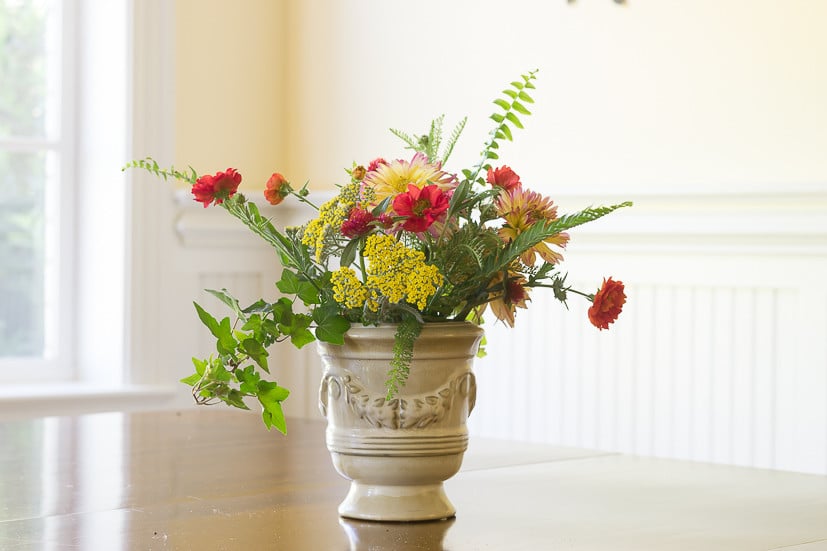
What are your favorite flowers and foliage for your cutting garden? I’m always looking for suggestions, so please send some my way.
If you want to refer back to this post in the future, make sure to bookmark it or pin the following image. You can also click the little heart at the right of the post to save it to your Grow account.
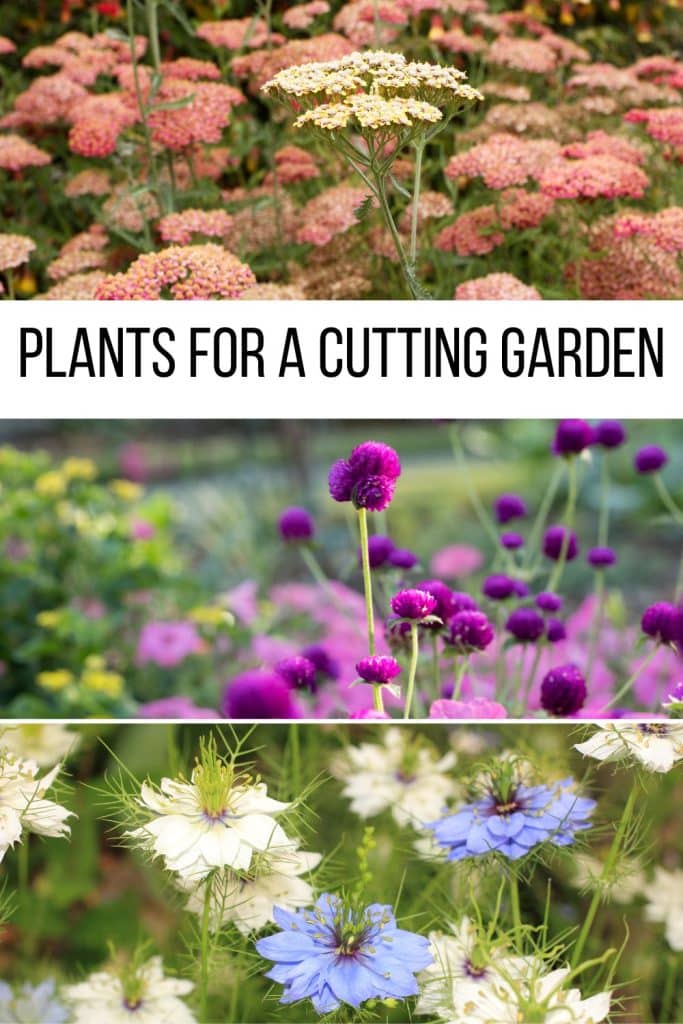
Thanks so much for spending a few minutes of your busy day with me!
To ensure you don’t miss future content, pop your email in the pale green box on the right or click here. I usually send one email weekly, so I won’t inundate your inbox. I’m sensitive to an overflowing email inbox!
We will only use your email address to send you emails, no more than 1-2 weekly. In addition, you will have access to my growing library of knit & crochet patterns and other printables. Check back often as this library will continue to grow. You can unsubscribe anytime by emailing me or clicking on the “unsubscribe” link at the bottom of all emails.
And you can access many of the products I refer to on my Nourish and Nestle Amazon Page. You can access it here.
So, if you’d like to participate in the ‘subscriber benefit’ action, simply subscribe to Nourish and Nestle here or use the form on the right sidebar. It’s slightly towards the top.
I have sent all my subscribers the link to the Subscriber Benefits Library. If you missed it or misplaced it, let me know.
Until next time…


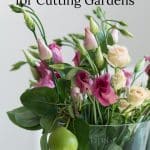
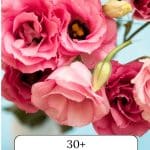

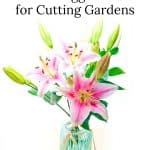

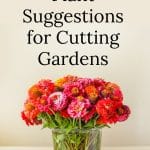
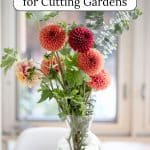
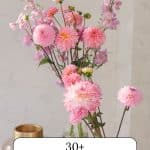
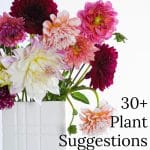
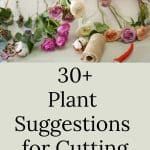


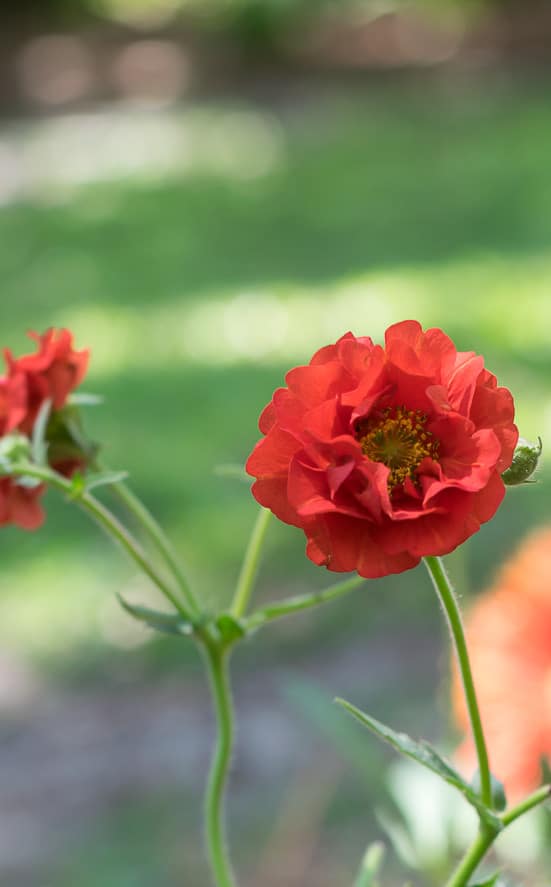

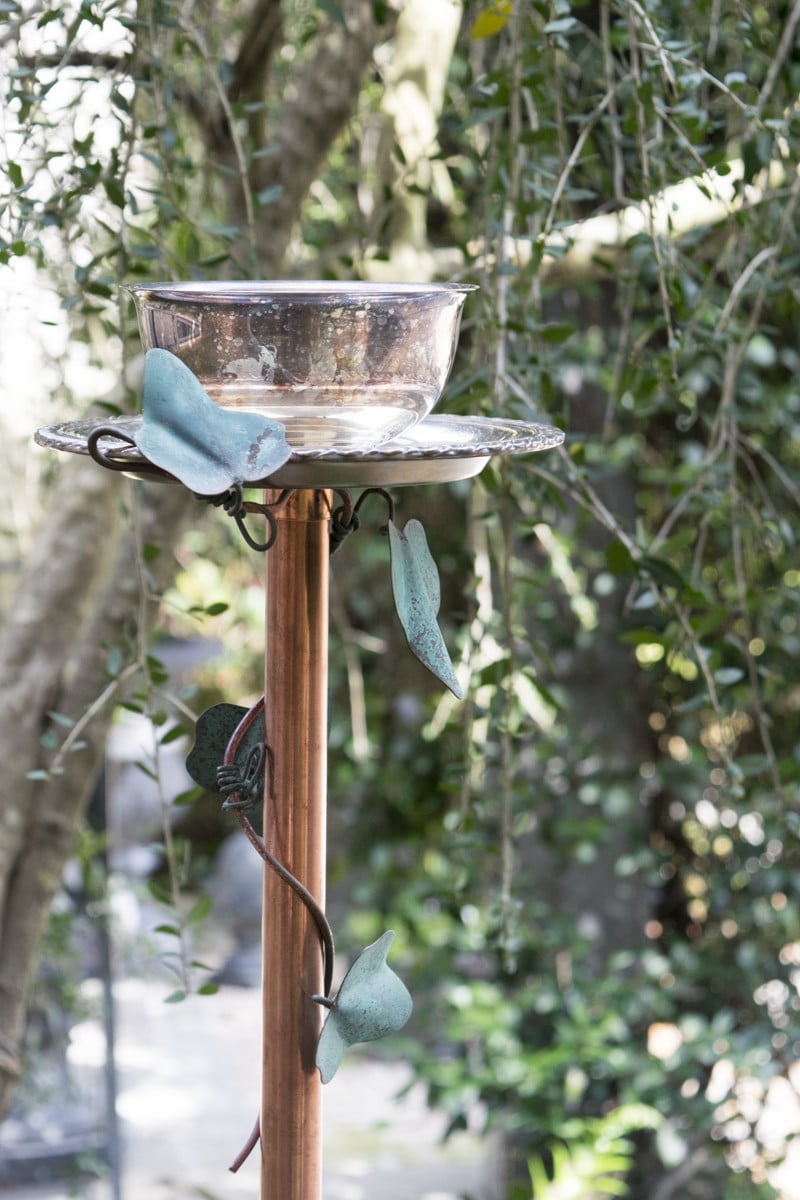
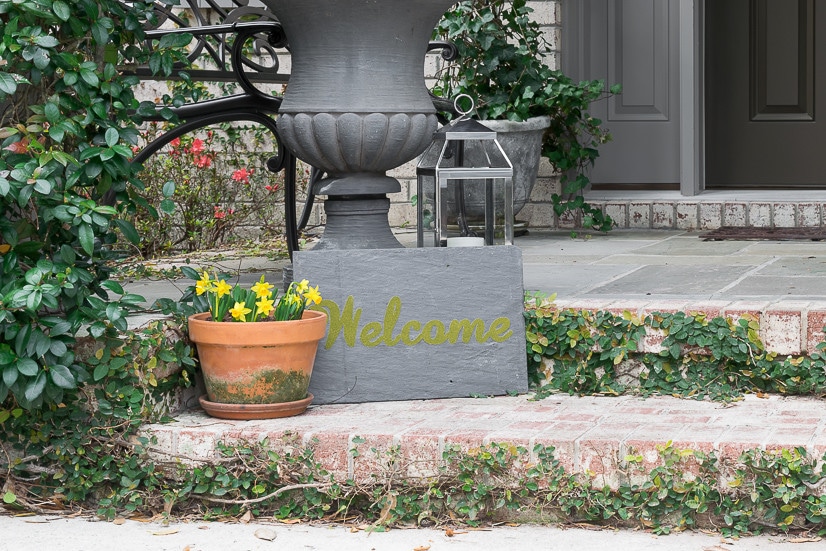
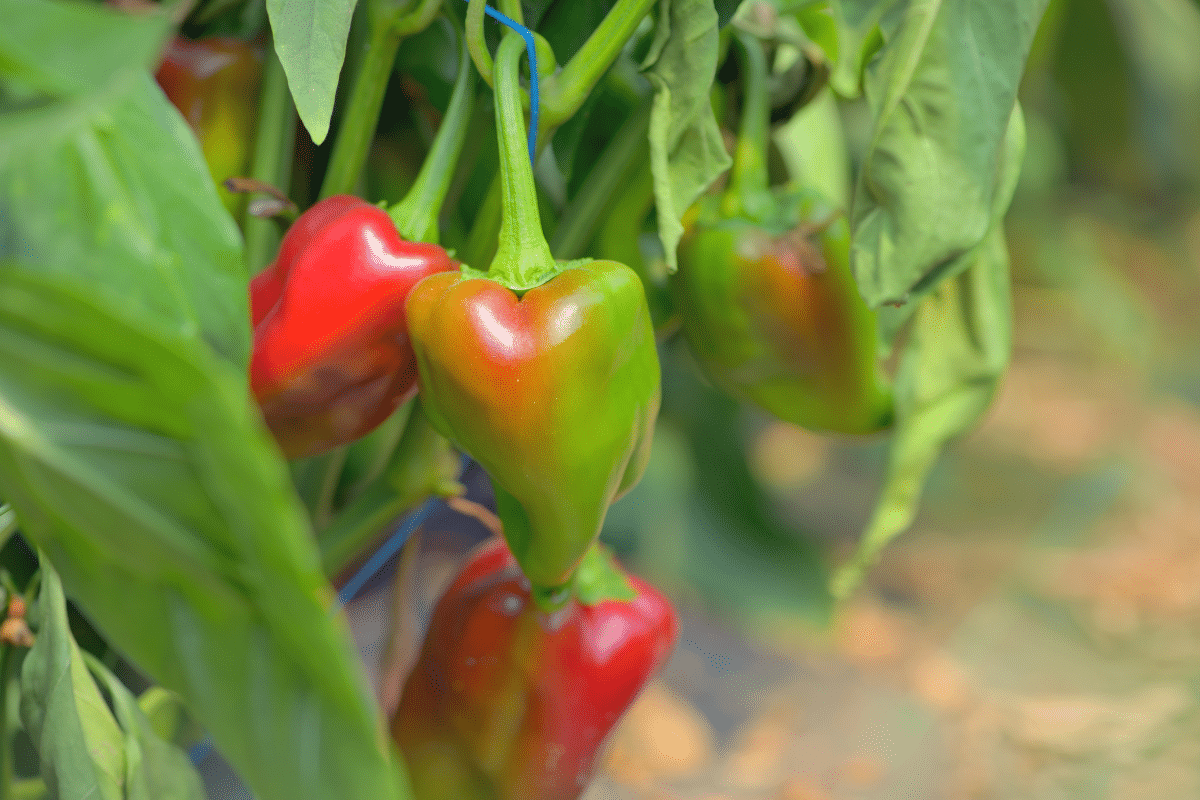
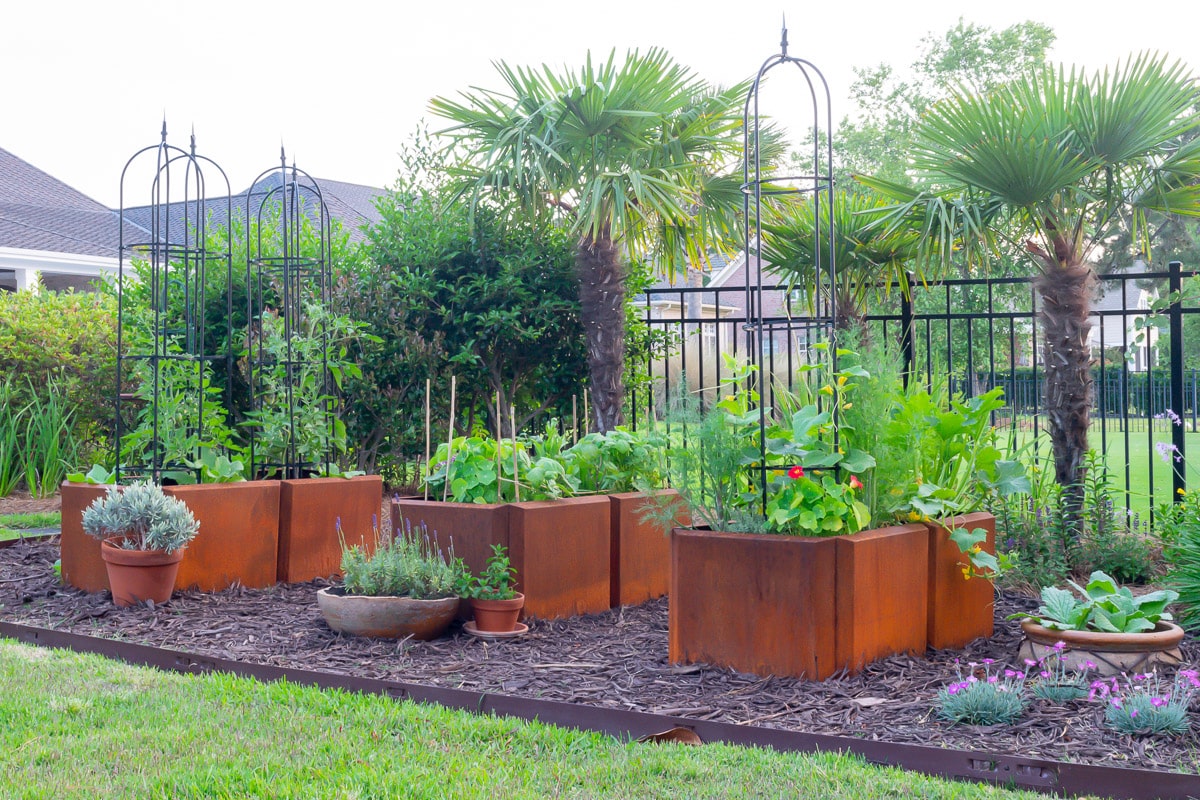
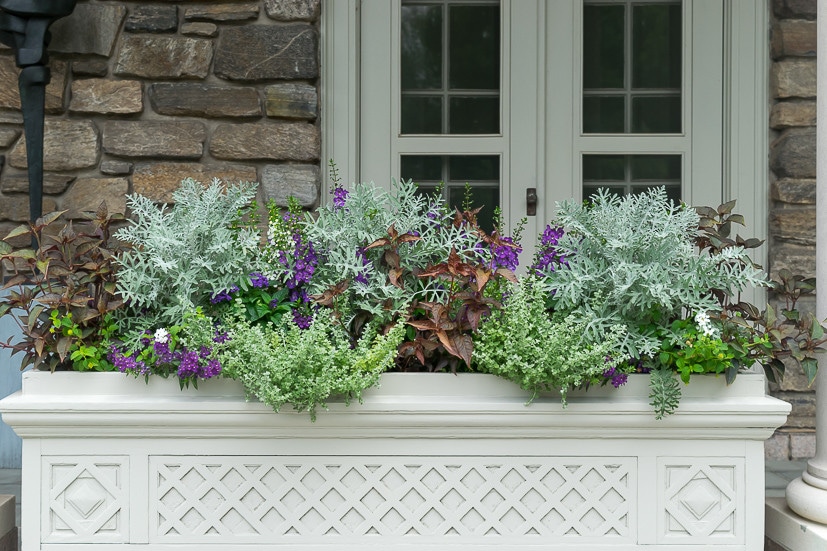
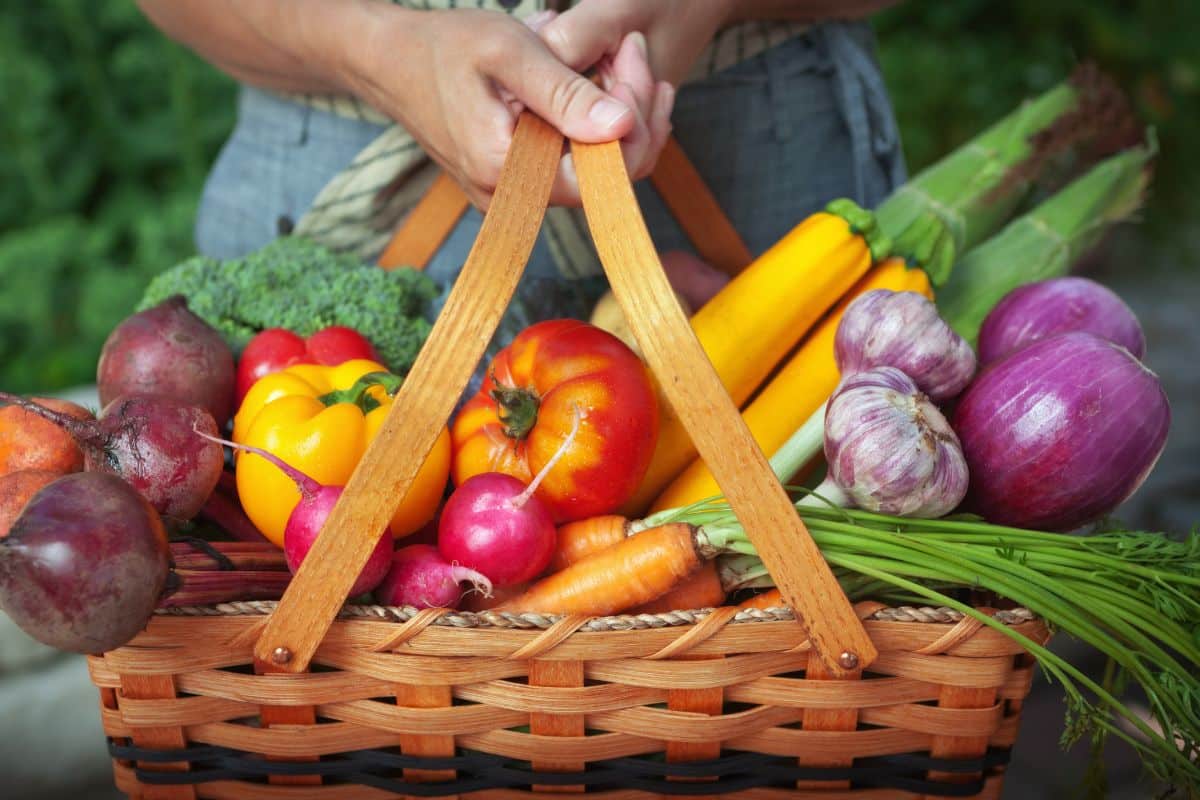
Your blog is beautiful! I am a new subscriber and am so pleased to have found you. My mother is still an avid gardener at age 87. I guess I inherited the desire to dig in the dirt, plant, and wait and see from her. I so enjoy cutting gardens and container gardening. It excites me to know what I will be able to learn from you. Thank you for the flower preservative recipe. I will definitely try it. Your photography is gorgeous. I guess I sound like a kid in a candy shop, but I really am glad to know there is a kindred spirit for gardening. Thanks, Lynn. Have a lovely end to your week.
Aw Sherry, you just put the widest smile on my face! Thanks so much for sharing your kind and encouraging words.
I love what I’m doing, but the whole process comes full circle when I know that there are folks out there who benefit from and enjoy the words I put out.
Like you, I come from a family of gardeners and doers, so it’s in my genes. My 82 year old parents still enjoy working in their garden as well…I know it keeps them young! In fact, today is my dad’s 83rd birthday! Heading over there shortly.
Thanks again for being a subscriber and for taking the time to pop in with your kind words.
Wishing you a wonderful Thursday.
Hugs,
Lynn
Great suggestions on what flowers to plant for bouquets. Love the container pictures too. I’m going to try the last one with the fern. Thank you!
Thanks for stopping by Betsy! I really do enjoy both my cutting garden, as well as my container gardens and so glad that I might have given you a few ideas! That’s surely my goal.
Good luck with your gardening…it’s a beautiful day here and hope it is where you are as well.
Many Hugs, Lynn
I love to be able to go out and into the garden for cut flowers. I’m working on that at this house we are in now. I had just gotten my flower beds how I wanted at the other house and pretty much year around I had some kind of flower or plant that I could cut to take to the cemetary. I lived taking fresh flowers that I had grown to my dad’s grave site. He is the one that got me into gardening.
What a lovely story…your dad inspiring you to garden has come full circle hasn’t it? I will be so sorry to leave all the gardens we’ve planted over the years when our house sells, I may just have to sneak a few plants to go with me.
Thanks for swinging by Linda!
Hugs, Lynn
Lol, that’s just what I did. I divided and took some with me. ?
Good Morning Lynn,
So enjoyed the gardening post this am. I was in need of a preservative recipe as well. Thank you. Also appreciate the great suggestions for the cutting garden, such a nice variety!
So inspiring…..Nan
Aw, thanks my very sweet friend. I’m chomping at the bit to get my hands in the dirt this spring. Once May rolls around, you will have so much more time to get dirty!
Hugs, Lynn
Good morning Lynn. Thank you for this post, it is inspiring me to make an cutting garden. All the flowers you mentioned to do love. So did you or do you suggest to stray all of these from seeds or ones in pots? And do you have them all in one planting plot? We have a lot of deer and rabbits around, not sure how much they will bother the flowers..?..
Thank you and have a great weekend.
Anne
Hey there Friend!!!
How are you all doing? All your kids home?
I actually started them all from pots and yes, they are all in one pot. I say they ‘are’, but I’m not 100% sure since we’ve moved! But, that being said, we didn’t have deer there and so can’t speak to the deer. However, we did have bunnies and they didn’t seem to bother the plants. Where we are now, even in the same neighborhood, we do have plenty of deer, so I am figuring out what plants deer will leave. Once I figure it out, I’ll let you know.
Hugs to your family and hope to see you in the fall.
Lynn
My favorite cut Flowers are tulips because they are so long lasting. I like to put ostrich ferns with them because they spread so rapidly in my garden and fill the empty spaces in my vase so well.
I love to read your whole blog when it arrives- so many lovely ideas to make and try. Thank you.
Hi Rita,
Just gave myself a good laugh! I read ‘ostrich feathers’ and then was shocked that they ‘spread so rapidly!’ I imagined all these ostriches in your backyard! And now I’m a little disappointed that it is just Ostrich ferns! 😁 Anyway, I agree that tulips are just a lovely flower! In fact, there are very few flowers I don’t enjoy, though I don’t grow roses. Just a little too persnickety for me.
Have a wonderful day!